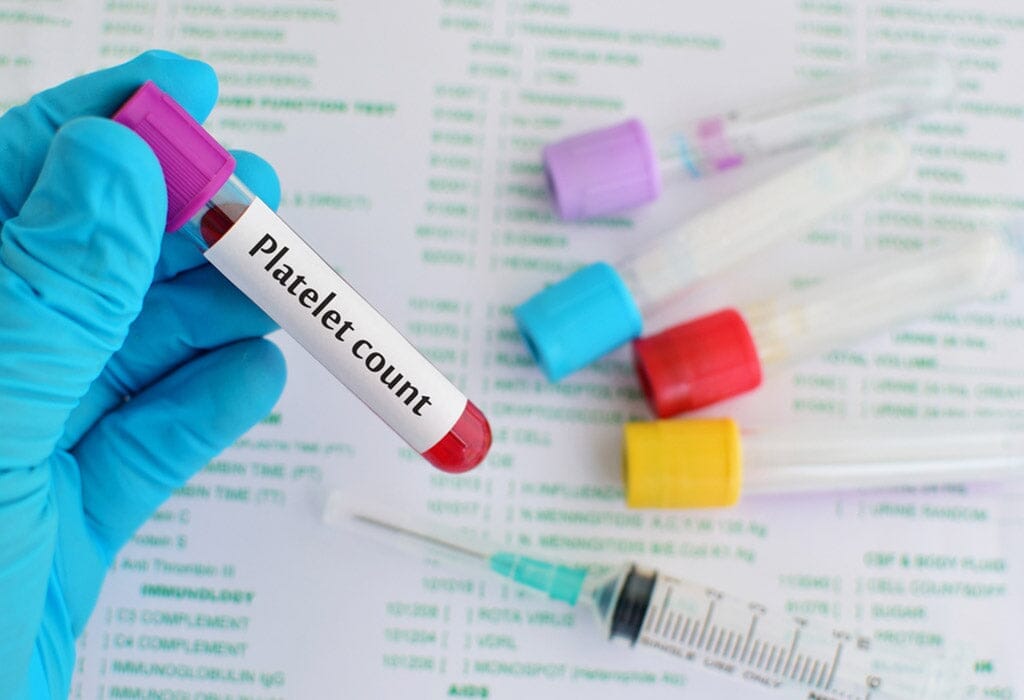
Platelet count blood test: Normal, low, and high values
Time to read 4 min
Time to read 4 min
Platelets are fragments of larger cells that are made in bone marrow. These fragments play a vital role in wound healing. In a single drop of blood, there are thousands of platelets. Abnormal platelet levels may cause various health complications. This post will discuss the process of a platelet blood test and the different values of the platelet level.
A platelet count test measures the number of platelets in the blood. High or low platelet levels may increase the risk of clotting or excess bleeding. A low platelet count may result in cancer, infection, or other health issues. On the other hand, a high platelet count can cause blood clots or strokes.
A platelet count blood test is part of a complete blood count (CBC) test. This test reveals important information about the number of blood cells in the body. By doing this test, you will know the average number of platelets a person has per microliter of blood.
Doctors can suggest this test individually or as a part of the CBC test. This quick test measures the number of present platelets in your blood. Platelets form blood clots when there is damage to the blood vessel. For instance, if you cut your finger, platelets mix with the clotting factors. Together they form a glue-like consistency that stops the bleeding.
The platelet normal range in an individual ranges between 1,50,000 and 4,50,000 platelets per microliter of blood. The platelet count below 50,000 is considered the lowest platelet count. This lowest amount of platelets can lead to different issues in the body. A count above 450,000 platelets per microliter is regarded as the highest platelet count. However, this platelet count varies by age and gender.
Platelet count is a simple and common test. The process of getting blood for a platelet count only takes a few minutes. You may get this test at your healthcare provider's office, lab, or hospital. Usually, a lab technician takes the blood samples. There are no serious risks associated with this test. However, you may face some slight risks that include;
If you have a low platelet count, your phlebotomist may ask you to keep the bandage on for some time. Also, they will monitor you for some time if you feel dizzy.
A low platelet count makes it difficult for the blood clot. Thus, it puts the person at risk of excess bleeding. It happens due to an inherited medical condition usually. If the platelet count falls below 20,000 per mcl, the person starts bleeding spontaneously. In such a condition, the person may require blood, platelets, or transfusion. A low platelet count may even increase the risk of death in people who experience traumatic injury.
There are some common causes that cause a low platelet count;
Platelet count usually declines with age. A lower platelet count in an older adult is not a cause for concern if there is no other symptom.
A high platelet count occurs when something causes the bone marrow to produce too many platelets. If the reason is unknown, it is called primary thrombocytosis. When an infection causes a high platelet count, it is called secondary thrombocytosis. Many factors can cause a person's platelet level to change. Some temporary conditions may cause a high platelet count that includes:
There are some chronic medical conditions like cancer, inflammatory disorders, iron deficiency anemia, spleen removal, or infections that may cause high platelet count.
A person's platelet level changes with age. Also, some medical conditions affect the normal platelet count. A low or high platelet count may lead to various health complications. A low platelet count is known as thrombocytopenia, and a high platelet count causes thrombocytosis. Normal platelet count ranges from 150,000 to 450,000.
Overall, we can say that a person's platelet levels change with age. It changes due to acute injury, deficiencies, and medication changes. Low platelets or excessively high platelet counts indicate the presence of an underlying health condition, injury, or infection. It's not possible to diagnose a medical condition based on platelet count only. You must consult a doctor regarding the number of platelets present in your body. Also, make sure to inform the doctor about any other symptoms that help narrow down testing options.
What is a dangerously low platelet count?
A platelet count below 10,000 per microliter is considered dangerous. It can lead to internal bleeding. A platelet count below 20,000 can cause bleeding even without any injury. In rare cases, thrombocytopenia may cause bleeding into the brain that can be fatal.
Is 130 a low platelet count?
130 platelet count is extremely low and can be fatal. It may cause extreme internal bleeding.
What is the normal platelet count by age?
The normal platelet range for adults ranges from 150,000 to 450,000 per microliter of blood.
What is a good platelet level?
A platelet count greater than 20,000 per microliter is considered a good level.
* * Medical Disclaimer: The following information is for educational purposes only. No information provided on this website, including text, graphics, and images, is intended as a substitute for professional medical advice. Please consult with your doctor about specific medical advice pertaining to your condition(s).



